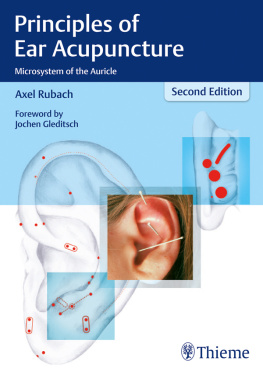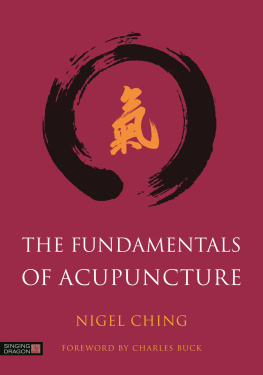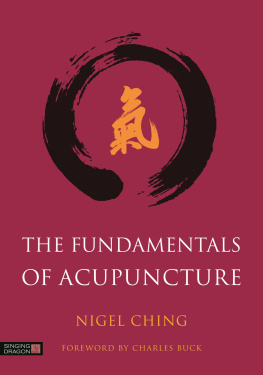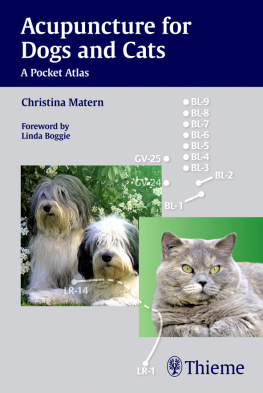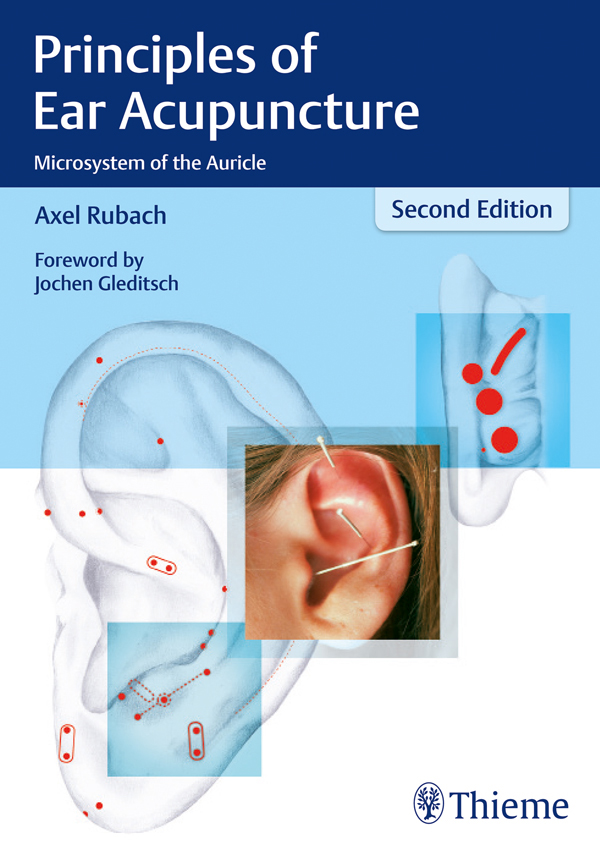Principles of Ear Acupuncture
Microsystem of the Auricle
Second Edition
Axel Rubach, MD
Private Practice
Munich, Germany
132 illustrations
Thieme
Stuttgart New York Delhi Rio de Janeiro
Library of Congress Cataloging-in-Publication Data is available from the publisher.
This book is an authorized translation of the 3rd German edition published and copyrighted 2009 by Hippokrates Verlag, Stuttgart. Title of the German edition: Propdeutik der Ohrakupunktur
Original translation by Ursula Vielkind, PhD, Dundas, Canada; new text parts translated by Ruth Gutberlet, Hofbieber, Germany
Ear illustrations: Axel Rubach; adaptations by Mathias Wosczyna, Wandlitz, Germany
2017 Georg Thieme Verlag KG
Thieme Publishers Stuttgart
Rdigerstrasse 14, 70469 Stuttgart, Germany
+49 [0]711 8931 421,
Thieme Publishers New York
333 Seventh Avenue, New York, NY 10001, USA
+1-800-782-3488,
Thieme Publishers Delhi
A-12, Second Floor, Sector-2, Noida-201301
Uttar Pradesh, India
+91 120 45 566 00,
Thieme Publishers Rio, Thieme Publicaes Ltda.
Edifcio Rodolpho de Paoli, 25 andar
Av. Nilo Peanha, 50 Sala 2508
Rio de Janeiro 20020-906 Brasil
+55 21 3172 2297/+55 21 3172 1896
Cover design: Thieme Publishing Group
Typesetting by Thomson Digital, India
Printed in India by Manipal Technologies Ltd., Karnataka
5 4 3 2 1
ISBN 978-3-13-125252-4
Also available as an e-book:
eISBN 978-3-13-169412-6
Important note: Medicine is an ever-changing science undergoing continual development. Research and clinical experience are continually expanding our knowledge, in particular our knowledge of proper treatment and drug therapy. Insofar as this book mentions any dosage or application, readers may rest assured that the authors, editors, and publishers have made every effort to ensure that such references are in accordance with the state of knowledge at the time of production of the book.
Nevertheless, this does not involve, imply, or express any guarantee or responsibility on the part of the publishers in respect to any dosage instructions and forms of applications stated in the book. Every user is requested to examine carefully the manufacturers leaflets accompanying each drug and to check, if necessary in consultation with a physician or specialist, whether the dosage schedules mentioned therein or the contraindications stated by the manufacturers differ from the statements made in the present book. Such examination is particularly important with drugs that are either rarely used or have been newly released on the market. Every dosage schedule or every form of application used is entirely at the user's own risk and responsibility. The authors and publishers request every user to report to the publishers any discrepancies or inaccuracies noticed. If errors in this work are found after publication, errata will be posted at www.thieme.com on the product description page.
Some of the product names, patents, and registered designs referred to in this book are in fact registered trademarks or proprietary names even though specific reference to this fact is not always made in the text. Therefore, the appearance of a name without designation as proprietary is not to be construed as a representation by the publisher that it is in the public domain.
This book, including all parts thereof, is legally protected by copyright. Any use, exploitation, or commercialization outside the narrow limits set by copyright legislation, without the publisher's consent, is illegal and liable to prosecution. This applies in particular to photostat reproduction, copying, mimeographing, preparation of microfilms, and electronic data processing and storage.
Foreword
In my foreword to the first edition, I expressed the wish that Axel Rubach's Principles of Ear Acupuncture would be widely distributed and accepted. This wish has been realized. It is considered the best textbook in this specialty area and has also become a standard reference in the English-speaking world.
Ear acupuncture has been established in Germany for over 50 years. This began in January 1951 when the German medical society for acupuncture DGfA (Deutsche rztegesellschaft fr Akupunktur) invited the inaugurator of auriculotherapy, Paul Nogier, to teach classes in Munich and thereafter included the method as a permanent feature of its training program.
Later, experiences from Chinese medicine were added and imparted through the DGfA lecturers Ingrid Wancura and Georg Knig. The coexistence of the two schools had a fruitful effect. Both systems have proved to be equally feasible and complement each other, providing patients with great benefits. Ear acupuncture is still the most effective and, in daily practice, the most common form of Western acupuncture.
The complete system of ear points has not only created new opportunities for diagnostics and therapy, but also directed attention to the phenomenon of microsystems in general, and to the existence of somatotopic representations of the entire organism in circumscribed areas. Sufficient scientific studies exist to document the effectiveness of microsystemic acupuncture.
In physics, complex nonlinear systems and the fractal phenomenon, as well as the view of the universe as holographic (described by David Bohm), have been recognized. From this, it is obvious that not only the aspect of self-reflection, but also systemic correlations between the whole and its parts, play a role within microsystems.
Those practicing ear acupuncture must be well acquainted with anatomy, point topography, and the particular indications for treatment. Axel Rubach introduces these topics illustratively and with practical orientation to the anatomy and morphology of the ear, the acupuncture points and their locations, and the specific indications of this method. The easiest way has proved to be the best: avoid complicated treatment procedures burdened with a number of therapeutic obstacles, but rather work out and communicate unambiguous point constellations (pools), knowledge of those points, and the resulting safety in their use.
This newly revised edition contains additional therapeutic examples and improved artwork. For many therapists, this second edition will provide helpful guidance in learning the method of practice, as well as serving as a reference text for those who are more experienced.
Jochen Gleditsch, MD
Otorhinoloryngology, Dentist
Honorary President of DGfA
Lecturer in Acupuncture,
University of Munich, Germany
Preface
This book resulted from an idea to create a fundamental work and textbook on the systematics of ear acupuncture. With this in mind, I would like to offer my utmost respect to all those who, since Nogier's ingenious insight, have paved the way for this method with their work and publications. They also laid the groundwork for this book. Additionally, the condensed knowledge and experience of many lecturers from the German medical society of acupuncture, DGfA (Deutsche rztegesellschaft fr Akupunktur), have contributed considerably to the success of this work.
I would like to express my gratitude to my teacher and friend, Dr. Jochen Gleditsch, to whom I owe my knowledge of this procedure and my enthusiasm for acupuncture in general. He initiated the idea for this book and was always on hand with help and advice. His book Maps Mikroakupunktsysteme, published in 2002, offers comprehensive and detailed insights into the essential microsystems of acupuncture and joins the phenomena of the individual microsystems into one concept.

